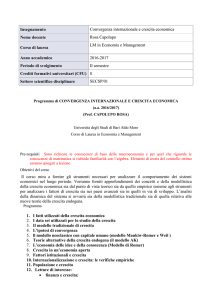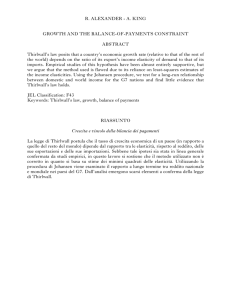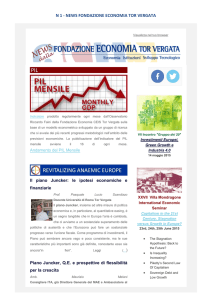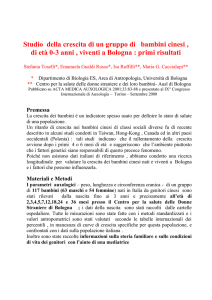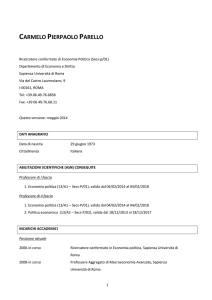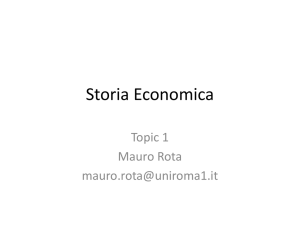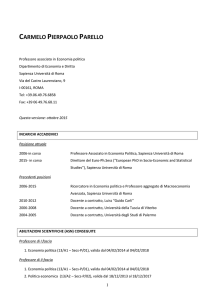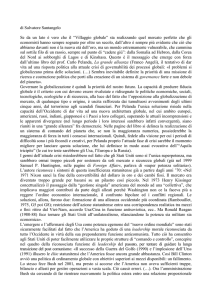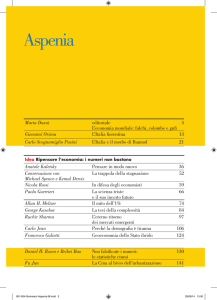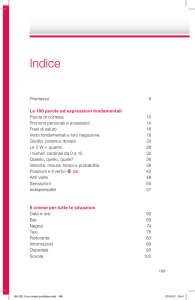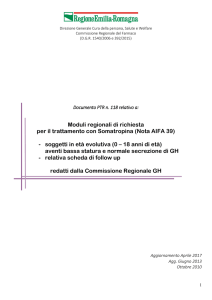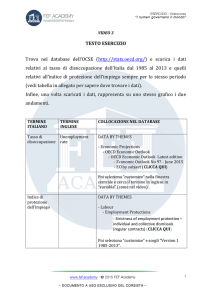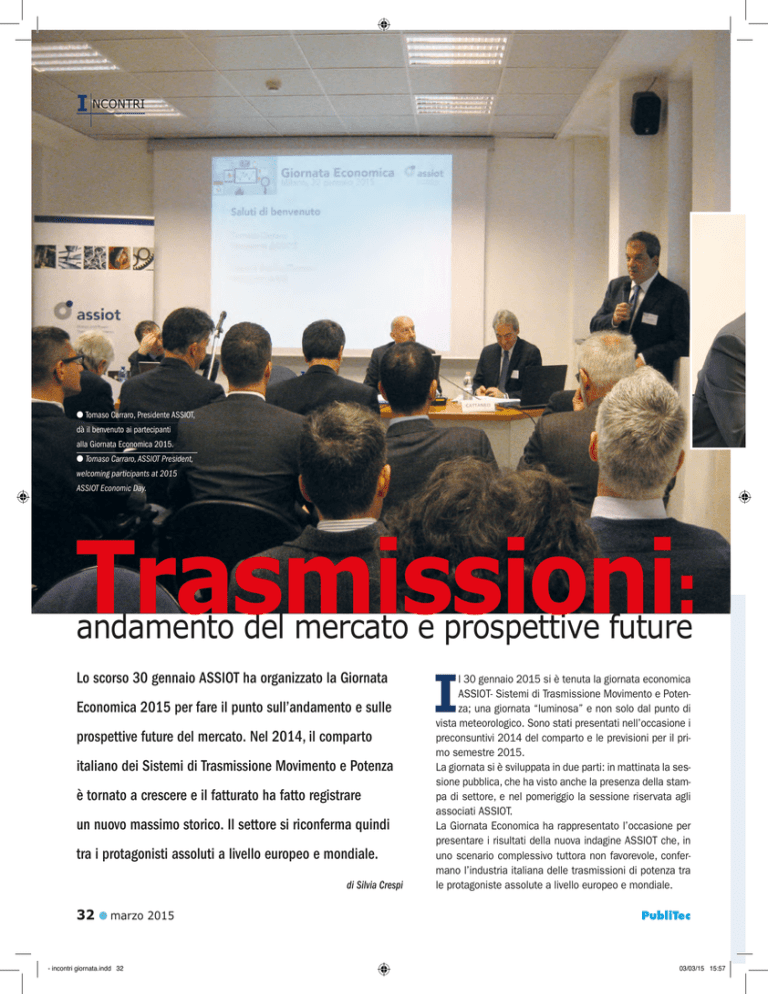
I ncontri
l Tomaso Carraro, Presidente ASSIOT,
dà il benvenuto ai partecipanti
alla Giornata Economica 2015.
l Tomaso Carraro, ASSIOT President,
welcoming participants at 2015
ASSIOT Economic Day.
Trasmissioni:
andamento del mercato e prospettive future
Lo scorso 30 gennaio ASSIOT ha organizzato la Giornata
Economica 2015 per fare il punto sull’andamento e sulle
prospettive future del mercato. Nel 2014, il comparto
italiano dei Sistemi di Trasmissione Movimento e Potenza
è tornato a crescere e il fatturato ha fatto registrare
un nuovo massimo storico. Il settore si riconferma quindi
tra i protagonisti assoluti a livello europeo e mondiale.
di Silvia Crespi
32 l marzo 2015
- incontri giornata.indd 32
I
l 30 gennaio 2015 si è tenuta la giornata economica
ASSIOT- Sistemi di Trasmissione Movimento e Potenza; una giornata “luminosa” e non solo dal punto di
vista meteorologico. Sono stati presentati nell’occasione i
preconsuntivi 2014 del comparto e le previsioni per il primo semestre 2015.
La giornata si è sviluppata in due parti: in mattinata la sessione pubblica, che ha visto anche la presenza della stampa di settore, e nel pomeriggio la sessione riservata agli
associati ASSIOT.
La Giornata Economica ha rappresentato l’occasione per
presentare i risultati della nuova indagine ASSIOT che, in
uno scenario complessivo tuttora non favorevole, confermano l’industria italiana delle trasmissioni di potenza tra
le protagoniste assolute a livello europeo e mondiale.
PubliTec
03/03/15 15:57
e
Uno sguardo all’economia globale
e alle previsioni di crescita per l’Italia
Per parlare di economia sono stati invitati Pierluigi Bellini,
IHS, Senior Analyst e Carlo Pelanda, Professore Straordinario di Economia, Università G. Marconi di Roma e Membro dell’Academic and Advisory Board di Oxonia (The
Oxford Institute for Political Economy).
Il primo ha fatto il punto sullo stato dell’economia globale
e le sue implicazioni nel settore automotive, che rappresenta uno dei principali mercati di sbocco del comparto
delle trasmissioni di potenza.
Dall’analisi mensile del Centro Studi Confindustria è emerso che nel 2014 l’economia mondiale ha proseguito nella
sua crescita (intorno al 2,5%), anche se a un ritmo più lento del previsto, e le prospettive sono positive anche per gli
anni futuri.
Sono gli Stati Uniti a “spingere” maggiormente con una
crescita intorno al 3,5% prevista per il 2015, mentre rallentano Paesi emergenti come Russia, Brasile e Cina (al
contrario dell’India che dovrebbe riprendere la sua corsa).
Il rallentamento di alcune delle economie emergenti sarebbe da imputare al venir meno dello stimolo monetario e alla restrizione del credito. Punti a favore potrebbero però
essere l'aumento, ancora lento, del costo della forza lavoro, il passo rallentato del processo di globalizzazione, la
mancanza di riforme interne e il ruolo ancora predominante dello Stato.
E l’Eurozona? Purtroppo risultati e aspettative non sono
ancora positivi, a causa della perdurante debolezza della
domanda interna; ci si attende una crescita limitata,
nell’ordine di qualche punto percentuale.
l Andrea Scanavini,
Presidente
Commissione
Economica ASSIOT
e Fabrizio Cattaneo,
Segretario ASSIOT.
l Andrea Scanavini,
President of ASSIOT
economic commission
and Fabrizio Cattaneo,
ASSIOT Secretary.
Special Report
Transmissions: Market Performance
and Future Prospects
During ASSIOT 2015 Economic Day on the 30th January, current performance as well as future
market prospects were debated. In 2014, the Italian Motion and Power Transmission Systems
returned to growth with the sector recording record turnover. Further confirmation of the industry
still being at the pinnacle of European and global demand.
On the 30th January ASSIOT- Motion and Power
Transmission Systems Economic Day took
place; an “enlightening” day, not only because
of the weather. End of year forecasts for 2014
were presented together with forecasts for the
first six months of 2015. The day was divided in
two: in the morning the public session, where
InMotion
- incontri giornata.indd 33
the press was also invited and in the afternoon,
the session exclusively for ASSIOT members.
The Economic Day was also an opportunity to
present ASSIOT new research into the state of
the market; in an overall context not entirely
favorable, the results confirm Italian industry to
be a leader at European and global level.
by Silvia Crespi
A look at global economy
and growth forecasts for Italy
Pierluigi Bellini, Senior Analyst at IHS, and
Carlo Pelanda, Economics Professor at the G.
Marconi University of Roma and member of
the Oxonia Academic and Advisory Board (The
Oxford Institute for Political Economy) were
invited to discuss the economic panorama.
The former looked at the state of the global
economy and the implications this will have on
the automotive sector, one of the main markets
requiring power transmission components.
march 2015 l 33
04/03/15 12:58
I ncontri
l Sistemi di trasmissione movimento e potenza (Preconsuntivi 2014 - milioni di euro). (Fonte: ASSIOT)
l Motion and power Transmission Systems (2014 forecast - millions euro). (Source: ASSIOT)
In gennaio, tuttavia, è aumentata la fiducia dei consumatori; cominciano a farsi sentire gli effetti della svalutazione
dell’euro e dell’abbattimento del costo del petrolio.
Per proteggere l’euro, la BCE ha finalmente lanciato il programma di Quantitative Easing (QE), che sarà più “ampio”
del previsto. Da questo mese di marzo, la Banca centrale
acquisterà azioni del settore, sia pubblico che privato, fino
a un massimo di 60 miliardi di euro al mese, superiore ai
50 miliardi attesi dai mercati. Il programma continuerà fino
alla fine di settembre 2016, e anche oltre se l’inflazione
non ritornerà sui livelli prestabiliti. L’ammontare totale del
programma dovrebbe essere, dunque, intorno ai 1.200 miliardi di euro, forse anche maggiore. L’aspetto negativo del
programma è che solamente il 20% delle eventuali perdite
legate all’acquisto di titoli verrà condiviso.
From the monthly report of Confindustria, the
Italian industrial confederation, we can see
that the global economy grew by around 2.5%
in 2014, at a slower pace than forecast, but
still confirming positive expectations for future
growth. The USA will be the growth engine, with
an increase of 3.5% forecast for 2015, while
emerging countries like Russia, Brazil and
China will slow (contrary to India who should
return to reporting strong figures).
The slowing of certain economies can be put
down to the lower policy stimulus and the
tightening of credit. The disadvantages of this
can be seen on future growth (there is also a
current slowing) in the cost of the workforce,
the reduced pace of globalization, a lack of
domestic reform and the overarching role of
the state.
And as for the Eurozone? Unfortunately, results
34 l marzo 2015
- incontri giornata.indd 34
Anche l’abbattimento del costo del petrolio giocherà un
ruolo importante nel processo di crescita mondiale. Il Fondo Monetario Internazionale stima che un calo del 10% del
prezzo del petrolio può fare aumentare dello 0,2% il PIL
globale.
Un ultimo sguardo al mercato dei cambi che prevede l’indebolimento dell’Euro fino al 2016, l’apprezzamento del
dollaro statunitense, l’indebolimento dello yen, e una sostanziale stabilità per lo yuan cinese e il dollaro canadese.
In Italia, nel 2015 dovrebbe finalmente terminare la lunga
recessione iniziata nel 2008, con PIL e occupazione previsti in crescita. Il Centro Studi Confindustria prevede una
crescita pari al 2,1% del PIL nel 2015 e un aggiuntivo 2,5%
per il 2016.
A determinare la crescita italiana, una combinazione di fat-
and forecasts are not positive, a continuing
weakness in internal demand and limited
growth which can be no more than a very few
percentage points. Consumer confidence did,
however, increase in January as the effects of
the Euro’s devaluation and the drop in oil prices
started to be felt.
The ECB finally launched its Quantitative
Easing (QE) plan to protect the Euro, which
will be “bigger” than expected. From this
March, the Central Bank will buy up bonds in
both the public and private sectors up to a
maximum of 60€ billion a month, more than
the 50€ billion expected by the markets. The
program will continue until September 2016
and even longer should inflation not reach
pre-determined levels. Total spending on this
project should be around 1,200 billion euro
and may be more. The negative aspect is that
only 20% of any losses coming from bond
acquisition would be divided among member
states. The lowering of the cost of fuel will also
be a crucial factor in global growth. The IMF
estimates that a 10% drop in the price of fuel
can increase global GDP growth by 0.2%.
A last look at the markets predicts the
weakening of the Euro until 2016, the
strengthening of the US Dollar, a weakening
Yen, and stability for the Chinese Yuan and
Canadian Dollar.
In 2015, the Italian economy should finally
come out of the recession it entered in 2008,
with GDP and employment levels growing. The
Italian industrial confederation predicts growth
of 2.1% in 2015 and up to 2.5% in 2016.
The factors determining this growth are
multiple: on top of the collapse of fuel prices,
and the devaluation of the Euro, the speeding
PubliTec
03/03/15 15:57
l Il Presidente della BCE Mario Draghi.
l ECB President Mario Draghi.
tori: oltre al crollo del prezzo del petrolio, alla svalutazione
del cambio dell’euro, all’accelerazione del mercato mondiale e alla diminuzione dei tassi di interesse a lungo termine, l’Italia dovrebbe trarre beneficio da una politica più
orientata alla crescita, dalla stabilizzazione della domanda
interna e della produzione e non ultimo, speriamo, da Expo
2015.
Le ripercussioni dell’economia
globale sul mercato dell’auto
Nel 2021 si prevede che circoleranno 1.35 miliardi di veicoli. Così esordisce Pierluigi Bellini parlando delle implicazioni dell’economia mondiale per l’industria automotive,
up of global demand and a drop in long-term
taxation rates, Italy should benefit from a
political will to create growth, a stable internal
demand and production level and, we hope,
from Expo 2015.
The consequences of the global
economy on the automobile industry
In 2021 there are forecast to be 1.35 billion
vehicles on the road. This was the opening
gambit of Pierluigi Bellini when discussing
future implications for the automobile industry,
focalizing his presentation on light vehicles.
Globally the automotive sector will continue
to grow, having an effect on the make-up of
the vehicles on our roads. There are various
points to consider. “Mature” markets are
being overtaken by emerging ones. China’s
car industry will continue to grow, will recover
InMotion
- incontri giornata.indd 35
l Pierluigi Bellini presenta un outlook sull’economia globale e le sue
ripercussioni sull’industria automotive.
l Pierluigi Bellini presented the state of the global economy and the
implications this will have on the automotive sector.
focalizzando il suo intervento sui Light Vehicles. A livello
mondiale l’industria automobilistica continua a crescere;
ciò che muta è la composizione del parco auto mondiale.
Vi sono alcuni elementi da prendere in considerazione. I
mercati ormai “maturi” stanno cedendo il testimone ai
mercati emergenti. L’industria automobilistica continuerà
a crescere in Cina, riprenderà in india, Brasile, mentre i Paesi dell’America latina sono tuttora penalizzati dalla crisi.
in India and Brazil while other Latin American
countries are still being penalized by the
economic disruption of recent years. Despite
these factors, the number of drivers, in both
China and India, is still low.
The UK shows the strongest growth in this
sector while Germany remains stable. Eastern
European countries have recorded positive
figures (excepting the already mentioned
Russia), while Western Europe is still feeling
the effects of the recession (with families still
preferring prudence to extravagance) meaning
growth in production is currently unlikely.
Italian industry facing
the challenges of the future
Professor Pelanda focused on the changes in
the configuration of the global market. We are
unquestionably in a moment of great evolution,
with the global market being fragmented into
“regional blocks”. This can be an opportunity
to re-organize the free trade area under new
boundaries to improve economic stability. This
cannot help but have an impact on industrial
strategy. The only strategy available to Italian
companies is that of becoming more flexible
and increasing in size in order to further their
financial influence. For SMEs is it essential to
be based on a business plan that can be easily
adapted to the changing market scenario.
Professor Pelanda also mentioned the TTIP
(Transatlantic Trade Investment Partnership)
negotiation, which sees the EU in a deal with
the US, which will hopefully have an impact
in terms of re-launching European business,
aligning with emerging economies and
maintaining a strong global influence.
The TTIP will hope to stimulate business
march 2015 l 35
03/03/15 15:57
I ncontri
l Fabrizio Cattaneo
ha presentato
l'indagine economica
ASSIOT 2014.
l Fabrizio Cattaneo
presented ASSIOT
economic survey.
Tuttavia, sia in Cina che in India la penetrazione di veicoli
commerciali leggeri è ancora bassa.
Tra i Paesi interessati dai risultati più favorevoli vi è il Regno Unito, mentre “tiene” la Germania. In crescita anche i
Paesi dell’Europa dell’Est (a parte la già citata Russia),
mentre in Europa occidentale si sente ancora l’eredità della crisi (con le famiglie ancora prudenti nella spesa) che
difficilmente farà crescere la produzione di automobili.
through a number of focalized actions,
including the opening of US markets to EU
companies, a reduction in excise duties on
exports and the definition of legislation that
will make exporting, importing and investing in
North America easier and more balanced.
Added value, as well as financial incentives,
can be crucial in helping business to increase
profit- margins. According to Salvi Piazza from
the company Officine Meccaniche in Piedmont
– the capitalization of a company’s know-how
(through an official inspection) can be a valid
form of finance. Flexibility must always be
coupled with financial “culture”.
Transmissions: end of year forecast
and expectations for 2015
The lively debate chaired by the ASSIOT
economic commission president, Andrea
36 l marzo 2015
- incontri giornata.indd 36
L’industria italiana di fronte
alle sfide del futuro
Il professor Pelanda si è soffermato sui mutamenti in atto
nella configurazione del mercato mondiale. Saremmo di
fronte a uno scenario in evoluzione, con una frammentazione del mercato globale in “blocchi regionali”. Un’opportunità è quella di organizzare aree di libero scambio disegnando nuovi confini allo scopo di raggiungere una maggiore sostenibilità economica. Ciò avrà naturalmente un
impatto sulle strategie industriali.
Per quanto riguarda le aziende italiane, l’unica strada da
percorrere è quella di acquisire sempre più flessibilità e di
diventare “più grandi” per poter disporre di maggiori risorse finanziarie. Per le PMI è essenziale costruire una strategia che permetta un’estrema capacità di adattamento ai
nuovi scenari che si prospettano.
Il professor Pelanda fa riferimento anche al negoziato TTIP
(Transatlantic Trade Investment Partnership o Partenariato
transatlantico su commercio e investimenti), che la UE è
impegnata a negoziare con gli Stati Uniti e che potrebbe
avere un impatto importante per rilanciare l’economia europea, per adattarsi alle economie emergenti e mantenere
l’influenza a livello globale.
Il TTIP si prefigge l’obiettivo di aiutare cittadini e imprese
attraverso una serie di azioni, tra cui l’apertura degli USA
alle imprese dell'UE, la riduzione degli oneri amministrativi
per le imprese esportatrici e la definizione di nuove norme
per rendere più agevole ed equo esportare, importare e investire oltreoceano.
Scanavini, brought all those present together
for the end of year forecast 2014 and the
target for 2015. The Italian Motion and power
transmission systems sector registered a
record year last year: + 5.2% on 2013 for total
revenues of over 6.5 billion euro.
Foreign trade data, in line with ASSIOT research,
shows positive trends for all variable business
contexts. Forecasts for the first semester of
2015 are equally positive. Signs of growth are
coming from both exports and internal market
demand.
Exports show strong growth in Asia (+10.9%),
with positive figures for both Europe (+4.5%),
and North America too (+3.6%).
Looking at the macro-categories in detail,
“gearing and transmission” has shown the
greatest growth (+7.7%).
The “Internationalization” index has stayed high
with almost 60% of production being exported
(including indirect exports this figure can be
over 80%.)
Internal demand is showing similar growth
(+5.3%) to that of foreign markets; Italian
companies are gaining benefit through being
more competitive than foreign importers.
Imports are also up by 5.2%, with Asia
representing the main point of origin.
The final balance of trade has also grown
(+5%), passing 1.6 billion euro for the first time.
Specific areas of growth (according to ASSIOT
research) have been seen in on road vehicles,
while the off highway sector continues to suffer.
Industrial machinery has stayed stable.
The last speech of the morning was by
Francesca Selva, Vice President Marketing &
Events at Messe Frankfurt Italy, who had the
opportunity to present TECO ’15. l
PubliTec
03/03/15 15:57
l Sistemi di
trasmissione
movimento e potenza:
preconsuntivi 2014
(dati in milioni di euro).
(Fonte: ASSIOT)
l Motion and power
Transmission Systems:
2014 end of year
forecasts (data in
millions euro).
(Source: ASSIOT)
Fatturato
Turnover
Export
Export
Consegne
Sales
Import
Import
Consumo Nazionale
Domestic consumption
Bilancia commerciale
Trade balance
Anche la creazione di valore, oltre alla leva finanziaria, può
essere di grande aiuto alle aziende per aumentare i margini.
Secondo Salvi Piazza delle Officine Meccaniche Piemontesi
– la capitalizzazione del proprio know-how (previa perizia) è
una valida forma di finanzializzazione. La flessibilità dev’essere di fatto accompagnata da una “cultura” finanziaria.
Trasmissioni: il consuntivo 2014
e le aspettative per il 2015
La presentazione dei consuntivi di fine anno e delle prospettive per il 2015, a cura del Presidente della Commissione Economica, Andrea Scanavini, ha coinvolto tutti i
partecipanti.
L’industria italiana dei sistemi di trasmissione Movimento
e Potenza ha fatto registrare, lo scorso anno, un massimo
storico: + 5,2% rispetto al 2013 per un fatturato di oltre
6,5 miliardi di euro. Tanto i dati di Commercio Estero quanto l’indagine Assiot confermano un andamento positivo
per tutte le variabili fondamentali di settore. Anche le previsioni per il primo semestre 2015 sono rosee. Segnali positivi riguardano sia le esportazioni che il mercato interno.
Per quanto riguarda le esportazioni, salta all’occhio il dato
relativo all’Asia (+10,9%), ma performance positive caratterizzano sia l’Europa (+4,5%), sia il Nord America (+3,6%).
Scendendo maggiormente nel dettaglio delle macrocategorie, “Ingranaggi e trasmissioni” è quella che ha fatto registrare la crescita maggiore (+7,7%). L’indice di internazionalizzazione rimane molto elevato: quasi il 60% della
produzione del comparto viene esportata (ma con il contributo dell’export indiretto si arriva a superare l’80%.)
La crescita del mercato domestico (+5,3%) è in linea con i
InMotion
- incontri giornata.indd 37
mercati esteri; le prime a trarne beneficio sono le aziende
italiane che si confermano competitive nei confronti degli
importatori stranieri. Le importazioni hanno fatto registrare +5,2% con l’Asia in primo piano.
Anche il saldo della bilancia commerciale di settore risulta
in crescita (+5%) superando per la prima volta la soglia dei
1,6 miliardi di euro.
In termini di mercati di sbocco, dall’indagine ASSIOT è
emerso un trend positivo per i veicoli su strada, contrariamente al settore off-highway, ancora in calo. Una sostanziale stabilità caratterizza i macchinari industriali in genere.
Nel corso della giornata economica, uno spazio è stato riservato anche alla presentazione di TECO’15, l'evento sulla meccatronica per l'automazione e la trasmissione di potenza, in programma per il 16 e 17 giugno 2015, da parte
di Francesca Selva, Vice President Marketing & Events di
Messe Frankfurt Italia. l
l Francesca Selva,
Vice President
Marketing & Events di
Messe Frankfurt Italia,
ha presentato TECO ’15.
l Francesca Selva,
Vice President
Marketing & Events di
Messe Frankfurt Italia,
presented TECO ’15.
march 2015 l 37
03/03/15 15:57

